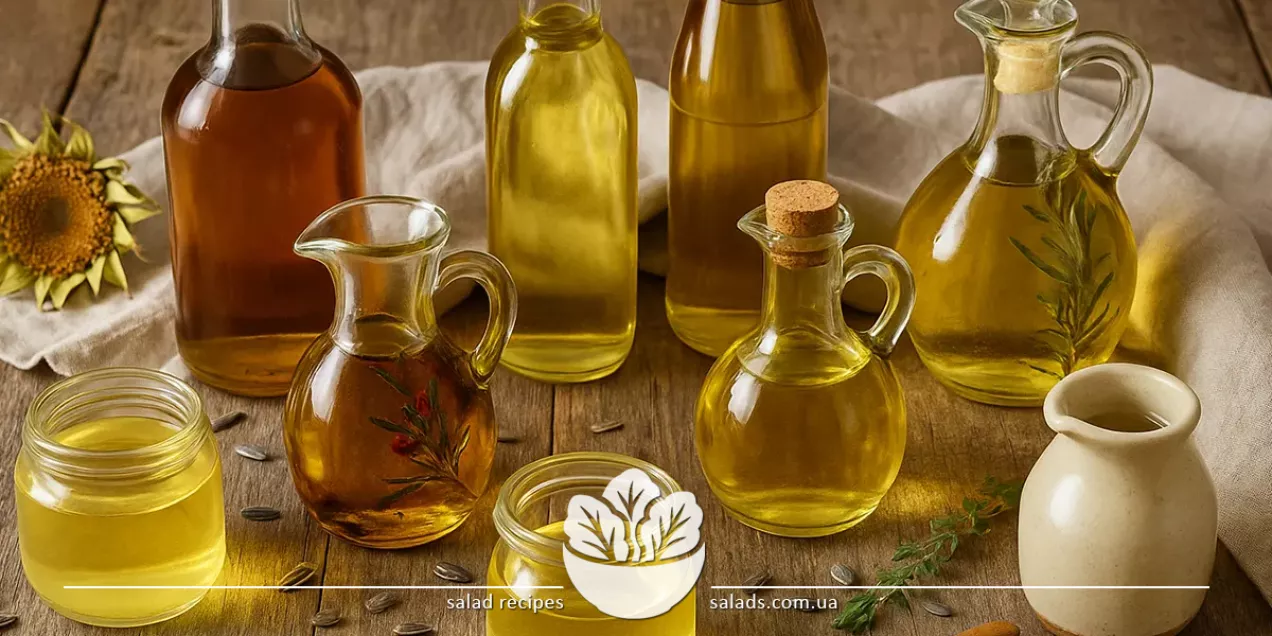Sunflower Oil

Sunflower oil is a traditional ingredient that plays a key role in both cooking and salad dressing. It is produced from sunflower seeds through pressing or extraction and undergoes various stages of purification. Refined oil is the most versatile – it is clear, odorless, and has a high smoke point, making it suitable for heat treatment. Unrefined (aromatic) oil, on the other hand, retains the seed aroma and is mainly used in cold dishes. Both types are ideal for dressings and pair well with vegetables, grains, proteins, spices, and even fruits. Read more about oils in the corresponding section.
Different Types of Sunflower Oil
Types of Sunflower Oil: Refined and Unrefined
Sunflower oil is available on the market in two primary forms: refined and unrefined. They differ not only in appearance and aroma but also in culinary purpose. Refined oil undergoes a multi-stage purification process, which removes its aroma and results in a clear, pale yellow texture. It has almost no flavor but a high smoke point (over 230 °C), making it ideal for frying, baking, and sautéing vegetables, meat, grains, or fish. Unrefined oil is cold-pressed. It has a deep golden color and a distinct aroma of roasted sunflower seeds. It is often chosen for cold dishes – salads, dressings, and vinaigrettes. It contains more bioactive compounds and natural antioxidants, but is not suitable for heating – its taste deteriorates and some nutrients are destroyed. The choice between the two depends on the intended use. If you need to fry vegetables for a salad, refined oil is the best choice. For dressing fresh ingredients, beans, or cooked grains, unrefined oil adds a rich homemade flavor. Both types retain nutritional value and are suitable for various culinary purposes, but they are used differently for best results.
Benefits and Composition of Sunflower Oil
Sunflower oil is not only a delicious cooking ingredient but also a valuable source of nutrients. It is rich in vitamin E – a powerful antioxidant that supports skin health, cardiovascular function, and cellular metabolism. It also contains fatty acids, especially omega-6 (linoleic acid), which help regulate cholesterol levels and improve vascular condition. Unrefined oil includes phospholipids, vitamin A, polyphenols, carotenoids, and other bioactive compounds. Sunflower oil is easily digestible and does not burden the digestive system. It is suitable for people with increased needs for plant-based fats – athletes, vegetarians, people on diets, or those in recovery. Due to its high content of unsaturated fatty acids, it is considered a healthier alternative to animal fats and margarine. However, it is important to maintain a balance between omega-6 and omega-3 by combining sunflower oil with other fat sources, such as flaxseed oil, olive oil, or fish oil. It can also be part of functional nutrition – for example, a salad with roasted beetroot, nuts, salad greens, and pomegranate dressed with unrefined oil is a rich source of fiber, vitamins, and healthy fats. This approach not only enhances flavor but also promotes daily health.
Use in Salads: Versatility and Nuances
Sunflower oil is one of the most popular salad dressings in home kitchens. Its neutral or nutty aroma (depending on the level of refinement) allows it to pair easily with vegetables, proteins, legumes, grains, fruits, and herbs. It is most commonly used in classic vegetable salads with tomatoes, cucumbers, cabbage, radishes, or beets. Its accessibility and versatility have made it a standard in many regional recipes. It can be used on its own or as a base for more complex dressings with vinegar, lemon juice, mustard, spices, or garlic. It works well in vinaigrettes, warm salads with roasted potatoes, grain mixes with bulgur or buckwheat, and meat salads with beef or chicken. Due to its density, it coats ingredients well, giving the dish a smooth, pleasant texture. The best results are achieved at room temperature – this prevents thickening and ensures even distribution. It is best added right before serving, especially in salads with fresh vegetables – this preserves their crunch and prevents sogginess. When combined with legumes or grains – for example, in a salad with beans, green onions, and egg – the oil enhances the texture and deepens the flavor.
Pairing with Other Ingredients
Sunflower oil pairs well with most ingredients used in salad preparation. Thanks to its mild flavor, it does not overpower the main aroma of the dish but gently supports the overall composition. The most harmonious pairings are with vegetables (cucumbers, tomatoes, cabbage, potatoes), herbs (parsley, dill, arugula), legumes (beans, chickpeas, lentils), and grains. It is also often added to dishes with chicken, fish, eggs, and in some cases, even fruits. This type of oil can serve as a base for dressings with mustard, honey, balsamic vinegar, or soy sauce. For example, a simple mix of 3 parts oil, 1 part acid, and a pinch of salt and pepper is a universal formula suitable for most salads.
This kind of dressing is especially effective in warm beet salads, grain mixes, or vegetable side dishes. Another interesting combination is with nuts – especially walnuts or hazelnuts. They enhance the natural richness of unrefined oil, adding crunch and fat content. In festive salads, the oil is often paired with orange, raisins, or almonds, creating bold flavor accents. A well-chosen sunflower oil can bring together ingredients with very different qualities – sour, sweet, salty, or bitter. This makes it a versatile culinary tool for achieving the desired balance.
Storage, Quality, and Cooking Tips
To preserve its flavor and health benefits, sunflower oil must be stored properly. It should be kept in a tightly sealed bottle in a cool, dark place. Direct sunlight, air exposure, and high temperatures accelerate oxidation and lower product quality. This is especially true for unrefined oil, which is more sensitive to external factors. When choosing oil, check for clarity (in refined oil) and a characteristic aroma (in unrefined oil). A quality product should not have bitterness or off-smells. Once opened, its shelf life is up to 1-1.5 months for unrefined oil and 2-3 months for refined oil. It is best purchased in dark glass bottles or stored at home in similar containers.
For salad preparation, it is best to use sunflower oil at room temperature. Before adding it, you can mix it with salt, pepper, mustard, or lemon juice to create a dressing that evenly coats the ingredients. For instance, a salad with bulgur, herbs, tomatoes, and roasted corn will taste richer thanks to a well-balanced dressing based on aromatic sunflower oil. Sunflower oil is an accessible, natural, and highly adaptable ingredient. Its versatility in salads allows for endless flavor exploration without compromising basic culinary principles.
